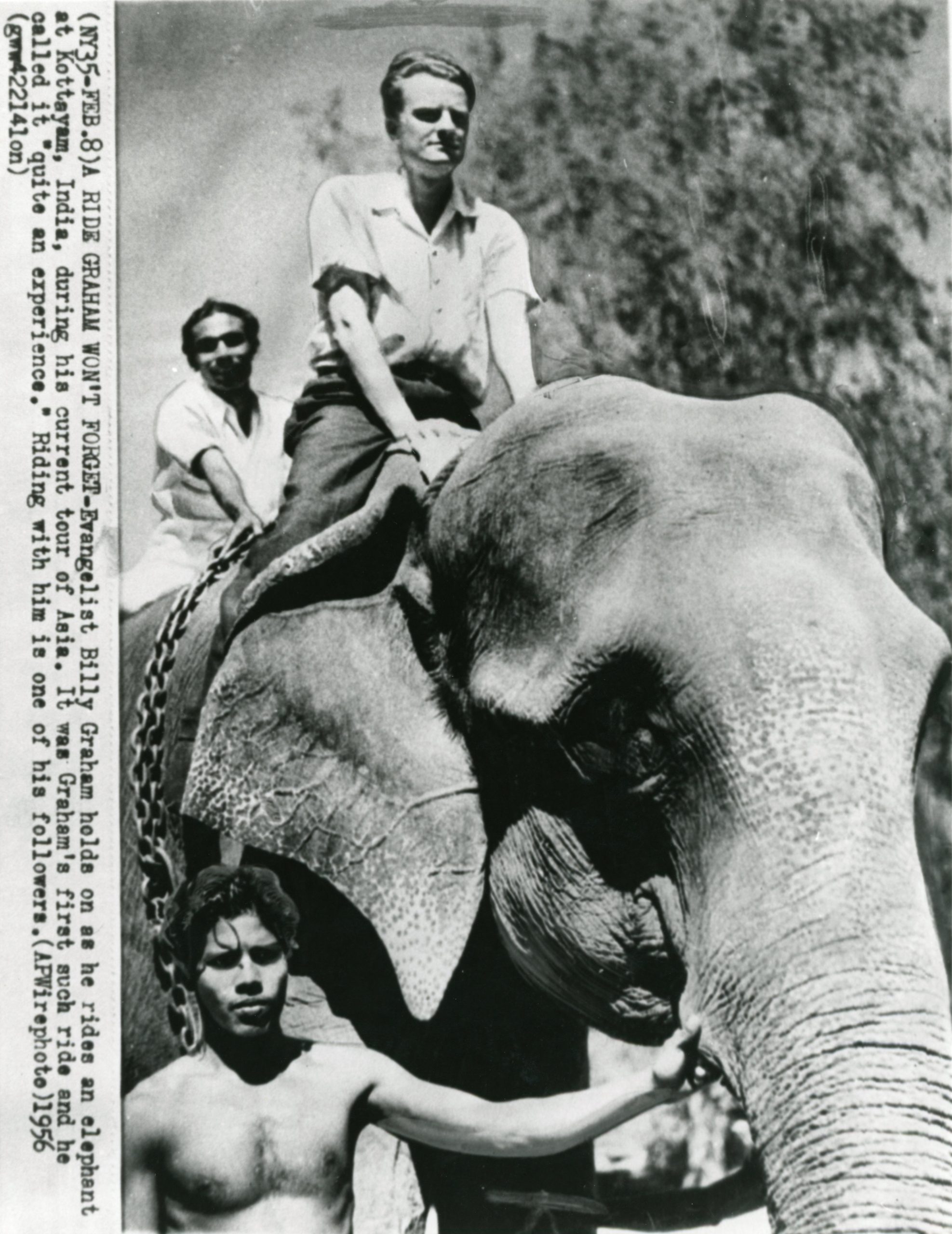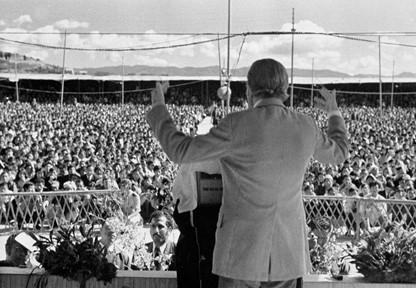Billy Graham’s Legacy in India
November 9, 2024
Categories: Billy Graham, Crusade City Spotlight
Billy Graham’s curiosity with India began while studying anthropology at Wheaton College, learning of the country’s multiculturalism and multi-religious nature. This fascination began preparing him years in advance for a relationship with the country of India that would continue even after his death.
After being encouraged by a key figure in the Evangelical Alliance in London, Rev. Graham scheduled Crusades in Bombay (now Mumbai), Madras (Chennai), Kottayam, Palamcottah, New Delhi and Calcutta (Kolkata).
His 1956 visit was timely, as India was beginning to strengthen its ties with the Communist bloc, raising questions about the role of Western influence and faith in the area. Billy Graham, however, was well prepared, taking the initiative to meet with the current secretary of state for a briefing on relations between the U.S. and India.

The first Crusade scheduled in Bombay was canceled due to violent riots that were unrelated to ministry efforts. While this was disappointing, it gave Billy Graham the opportunity to observe the local culture and experience the overwhelming poverty in the area. This insight gave him a better understanding of the community’s physical and spiritual needs.
His second stop in Madras was met with overwhelming support with thousands traveling large distances – some even riding the train for days to attend the Crusade. While in the area, Rev, Graham experienced many practices of Hinduism, visiting a Hindu temple and observing sacrifices to priests.
His observations emboldened his message as he preached to crowds of 40,000 with translations taking place in Telugu and Tamil. Knowing the cultural understanding of Christianity, Billy Graham emphasized the truth of Galatians 3:28 – that “all are one in Christ Jesus.”
In his autobiography, he wrote, “We could see the people’s eyes light up as they realized that Christianity was not exclusively for Europeans or the white race but that Christ came for all.”
With about 100,000 attendees in Madras, 4,000 people indicated a decision for Christ. In addition, Mr. Graham got to speak at a local student gathering, where over 200 students responded to the Gospel.
Kottayam, the third stop of the tour, only had a population of 50,000, but the first meeting attracted 75,000 people.
Indian custom required women to sit on a different level from the men, so women and girls had ingeniously carved a hill into an amphitheater with many levels so all could hear Mr. Graham’s message, showing their eagerness to hear the Gospel.
The final crowd hit 100,000 totaling the total of the few days in Kottayam to over 300,000. The large crowds did not change Mr. Graham’s message. Although, he was sensitive to their current practice of religion, being intentional to not attack their beliefs, but trusting that the Holy Spirit would replace false beliefs and practices.
In Palamcottah, Mr. Graham was welcomed by large cheering crowds – so much so, that he had to crawl out of a window after a meeting as the crowd was so large inside and outside.
The support was incredible, but Mr. Graham began to fear that the Hindus were beginning to view him as a god. He repeatedly pointed them to God, reminding them that he was only a man.
While in New Delhi, Billy Graham met with the current prime minister, engaging him in a conversation about Jesus Christ. The prime minister was very engaged, asking many spiritual questions. The prime minister also complimented the work that Mr. Graham’s team had done in the country.
At the New Delhi Crusade, the Hindustani interpreter experienced a call to evangelism. He would later join Mr. Graham’s team as an associate evangelist.
Mr. Graham embraced Indian culture in many ways, including bringing a sar home to his wife, Ruth. He was impressed by the kind nature of the Indian people he encountered and said he will always identify India as the country he would love to return to.
Billy Graham returned to India in 1972 to preach in Nagaland, an area that had become unstable due to tensions among local tribes and an armed guerrilla movement. After almost canceling the meeting due to continued guerrilla activity and ambushes, Mr. Graham was encouraged to continue with the plans of the Crusade. Trusting that God would keep him and the attendees safe, the Crusade continued as planned.

500,000 people attended Billy Graham’s Crusade from November 20-22, 1972. The crowd included many different tribes, each having their own interpreter. Mr. Graham took note of the attendees’ tribal dress, painted faces, and spears in hand as he preached from the platform, declaring God’s love for them.
A cyclone and tidal wave killing 100,000 and destroying numerous villages in India presented Billy Graham with the opportunity to serve a traumatized and discouraged people.
By God’s providence, Mr. Graham was already in India for ministry purposes, giving him access to the otherwise restricted country.
Through the Billy Graham Evangelistic Association (BGEA)’s World Emergency Fund, a village in India was rebuilt from the ground up. In 1980, citizens dedicated their town to Mr. Graham, naming it “Billy Graham Nagar (Village).”
BGEA’s World Emergency Fund continues to help places experiencing disaster, illness or economic need, reflecting the Bible’s command to “bear one another’s burdens,” (Galatians 6:2).